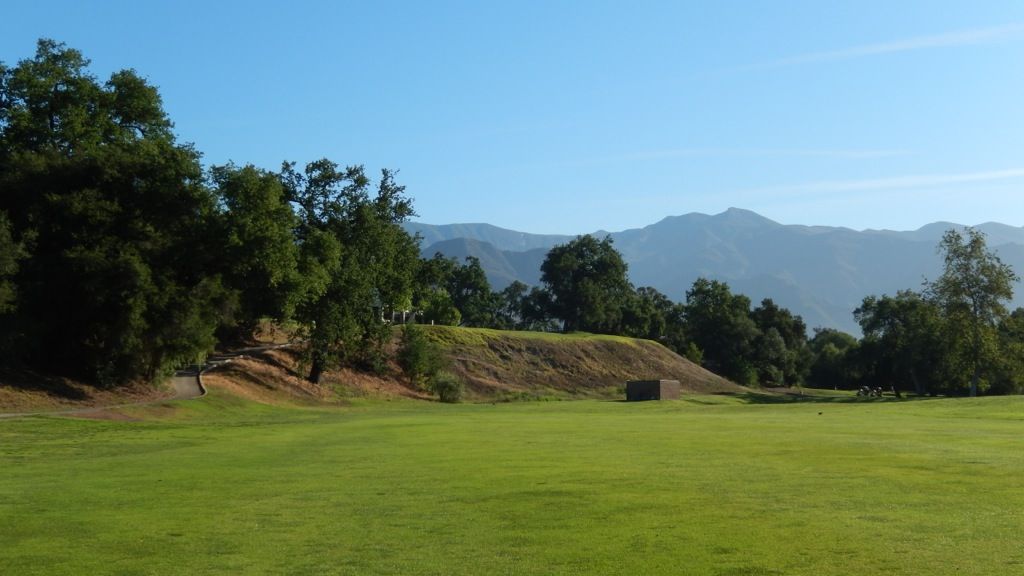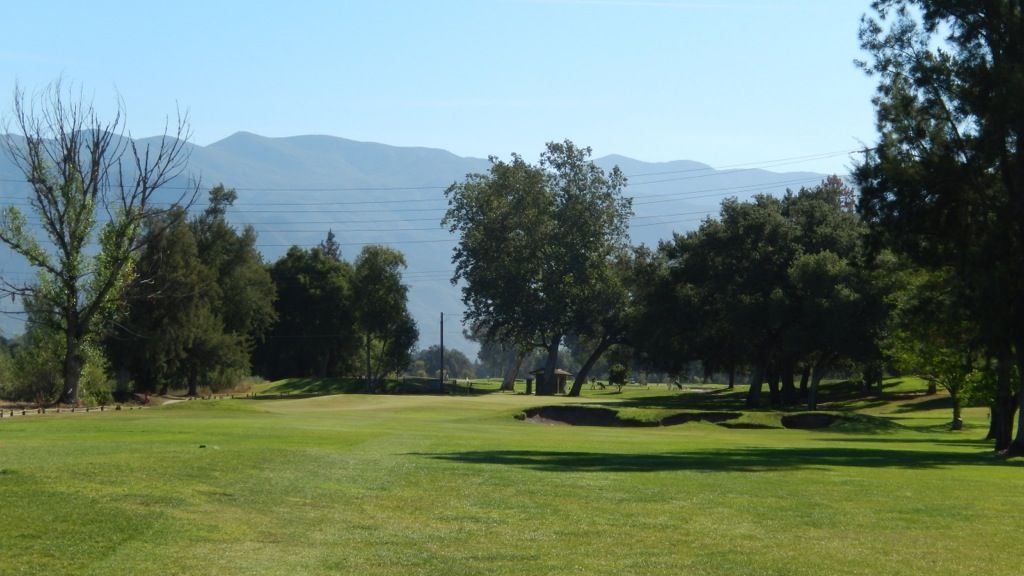Ojai, California, United States
Architects: Billy Bell; Renovation by Gil Hanse and Jim Wagner (2005)
6,806 Yards, Par-72
Rating/Slope: 72.3/126
My Quick Review: Great value in an area with terrible public golf.
Soule Park is FUN. And it is a golf course that most with an interest in architecture will really like. In 2005, Gil Hanse and Jim Wagner were brought in to renovate (not restore, I believe) Soule Park. I don't know the extent of the work involved, but I was told when I played that some of the older members found the renovation too severe -- with bunkers too deep, and top shot / carry bunkers that could not be carried! I was told the work had been softened some (not sure if this was done by Hanse / Wagner, or if not, if it was done with their blessing), but regardless, what is on the ground today makes for a very enjoyable round.
The first is a short, downhill par-4 that plays from a dramatic tee location, steps from the clubhouse:

The bunkering set into a ridge short of the green deceives the golfer, hiding a gully, and making the green appear closer than it is:

Another shortish par-4 at the 2nd, where the golfer must take on a series of bunkers on the right for a preferred line into the green. The approach to the 2nd is dominated by a swale short-right of the green, but clever golfers will use the slope over the left bunker to funnel their approach onto the green:

The 3rd is only 145 yards, but deep greenside bunkers and a blind putting surface make this an intimidating tee shot:


The 4th is a relatively benign 505 yard par-5, but interest is created by the pairing of cleverly placed centreline bunker 70 yards from the green, and a green with a severe spine splitting it left and right. This golfer (me), having laid-up in the wrong side of the fairway, now has a very difficult pitch into the green:


Back-to-back par-5s are a rarity, but the pair of holes at Soule Park should keep most golfers' interest. Approaching the green, the golfer must play over a diagonal ridge to a blind green. If the golfer takes on the shorter carry, the leftward slope will kick his ball into rough. Only golfers taking on the bold line to the right will find the putting surface:

The first-time golfer, not knowing what the green site will look like, will no doubt have a smile on his face as this wonderful punchbowl is revealed:

After the very birdieable 4th and 5th holes, the golfer starts to move back up the hill with the 245 yard 6th:

The drop-down green at the 7th is another exceptional one. Check out this diagonal ridge in the green! Missing on the wrong side can mean an impossible recovery:

Another difficult hole at the uphill, 420 yard 8th. In truth, this is one of the least interesting tee shots on the course, but the golfer will do well to play to the right to leave a simpler angle of approach into another severe green:

In my opinion, the 333 yard 9th misses the mark. Not only are the mowing lines off (fairway should run up to and left of the trio of fairway bunkers), but the green orientation is such that the golfer will not be sufficiently enticed to risk the dangerous line from the tee. As seen below, these three bunkers run diagonally across the left side of the hole, but it is a drive to the right, away from the bunkers, that leaves the preferred angle of approach.

The 10th is a drop-shot par-3 with water tight to the green on the right -- a hole the masses will likely love and the bearded will hate:

The 11th is a mid-length par-5 with a perfect pairing of a well-placed centreline bunker in the lay-up area and a series of built-up mounds running along the left side of the green:

At the 12th, golfers that play near the fairway bunkers on the right will enjoy a preferred angle of approach into the green, which falls off sharply on the left:

Up then down the terrain go the 14th and 15th. The 14th offers a seemingly uninteresting tee shot, but play to the wrong side of the fairway and the golfer will have almost no chance of finding the well protected 14th green:

And the tee shot at the 15th, well, it really just isn't very interesting...

The 16th is a 160 yard par-3 that plays to a sharply tilted green tucked into the hillside:

The 17th and 18th stand alone on the opposite side of the clubhouse and occupy the flattest land on the property. The 17th is eminently forgettable, as is the 18th, but for the potential thrill of an eagle and a three-tiered green:


No comments:
Post a Comment